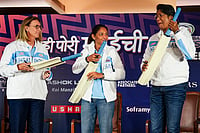Prime Minister Narendra Modi on Thursday hailed the 1998 nuclear tests in Pokhran as one of the most glorious days in India's history, and asserted that technology for the country is not about showing its dominance but a tool to speed up its development.
Addressing an event on the National Technology Day, which marks the anniversary of Pokhran tests, Modi said his government has used technology as a source of empowerment and to ensure social justice.
Be it JAM trinity, CoWIN portal or digital market for farmers, his government has used technology as an "agent of inclusion", he said, adding that there is some technological solution available at every stage of life right from one's birth.
The prime minister said his government's thrust on science and technology has ushered in a big change and noted that around 4,000 patents used to be registered annually 10 years back but it is over 30,000 now.
Against 70,000 trade marks being registered annually earlier, the figure is now over 2.5 lakh while the number of incubation centres has risen to 650 from 150 in 2014, he said.
The country is moving in every direction which is needed to be a tech leader, he said. The prime minister said his government has worked to make an inclusive ecosystem to promote innovation and cited India's big jump on the global innovation index.
Modi also laid the foundation stone of Laser Interferometer Gravitational Wave Observatory India (LIGO-India).
He dedicated to the nation a Rare Earth Permanent Magnet Plant at the Bhabha Atomic Research Centre campus at Visakhapatnam and a Fission Moly-99 Production Facility in Mumbai, which will produce the radioisotope used in more than 85 per cent of imaging procedures for early detection of cancer and heart disease.


























